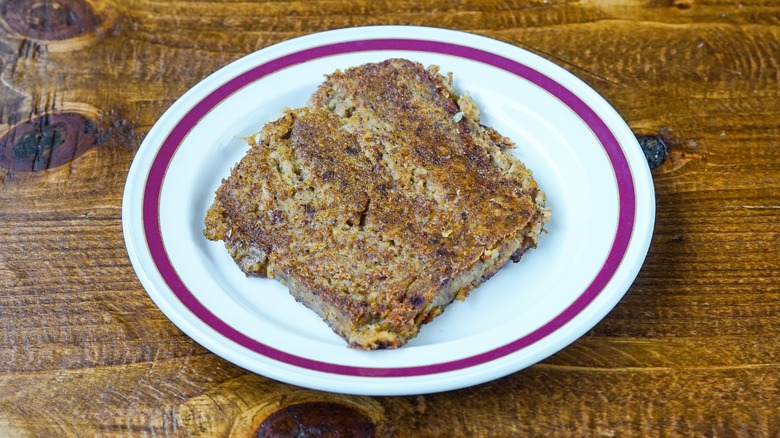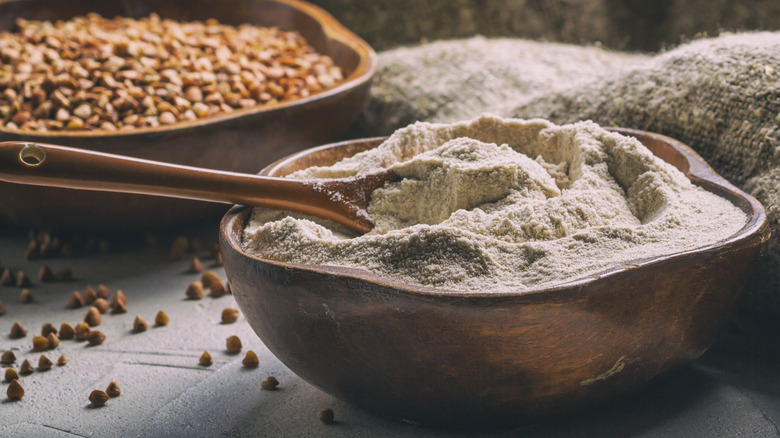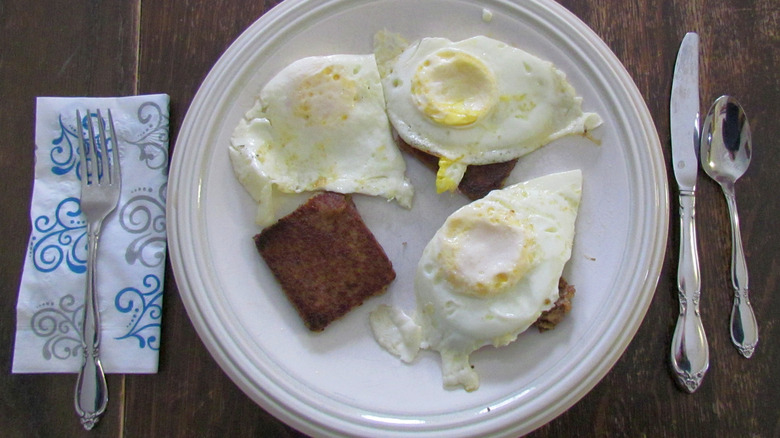Scrapple's Color Is Due To One Specific Ingredient
Perhaps more than any other mainstream meal, breakfast highlights all of the most famous farm animals and the gifts they give us, including milk, cheese, eggs, bacon, sausage, and sometimes scrapple: a mysterious, mushy gray meat block. If you've ever wondered about this culinary enigma, Food Network explains that scrapple is made from pork, spices, and cornmeal or flour, all of which are cooked before cooling into a loaf that is later cut into pieces.
Scrapple's meat comes from pork trimmings, which may include end pieces but also organs, tails, skin, and even meat from the head of the pig, including the tongue and jowls.
Scrapple is a fully cooked product and can be eaten straight out of the package, but the proper way to eat it is pan-fried to a deep, crusty golden brown. But before that Maillard magic happens, its out-of-the-box color can be challenging. Where did scrapple come from, why on Earth does it look like that, and how do you go about eating it?
Scrapple's sizzling story
According to Thrillist, scrapple came to the United States via German immigrants (the Pennsylvania Dutch) and was probably named for the word panhaskröppel, roughly translating to "pan rabbit" — not a reference to the tasty tidbits that comprise the stuff. The dish made the most of what frugal folks had on hand, without wasting anything — even cooking the meat and cornmeal or flour components in a broth made from pork bones, says the Farmer's Almanac. Traditional buckwheat flour, which is gray, is the culprit behind scrapple's look (per Thrillist).
Thrillist names Philadelphia as the country's biggest consumer of scrapple, though it's also popular in New Jersey, Delaware, Maryland, West Virginia, and Virginia (per the Farmer's Almanac). And in the south, it's known as "livermush" (per Food Network). It's also sold as panhaas or ponhaus.
Scrapple can be found in grocery stores and butcher shops, but it's a regional specialty and only made by a select few producers and processors, according to Esquire. You might encounter it in mid-Atlantic diners and breakfast joints. The Farmer's Almanac adds that today, scrapple is increasingly featured on the menus of culture-centric restaurants.
Scrapple is not scary
So, what does scrapple taste like, anyway? Food Network says it's akin to pate when it contains liver and more like a breakfast sausage if it's got sage in it. If you're looking for a real adventure, you can try your hand at making it at home and eat it with fried eggs and toast. Perhaps it's time bacon gets knocked off its high horse. The Farmer's Almanac suggests serving scrapple with sweet condiments such as ketchup, maple syrup, or apple butter, all of which complement scrapple's savory, meaty characteristics.
In a time when eaters are increasingly interested in nose-to-tail eating, scrapple is an easy, accessible entry point. Healthline explains that organ meats are a great way to stock up on nutrients including vitamin B12, folate, and minerals iron, zinc, selenium, and magnesium: all the more reason to give it a try. (You don't need to handle and can't even see any of the offal cuts involved in scrapple.)
When cooking scrapple, Esquire cautions not to slice it so thin that it burns or so thick that its middle oozes like uncooked pancake batter. It's also a long wait for the slices to get that perfectly-seared crust in your skillet. But be patient and diligent, and you'll enjoy crisp-on-the-outside, creamy-on-the-inside goodness. The only thing that's hard to stomach about scrapple is the dedication involved in getting it right.


